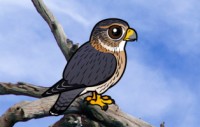2014 Bonanza Bird #1: Merlin

The first bird in our 2014 Bonanza is a small falcon with a widespread range: the Merlin! The Merlin is a small-sized falcon found across much of the northern hemisphere. For... Read more »
The Merlin is a small but fierce bird of prey, often admired for its agility and speed in flight. This compact falcon has a broad, tapered wing and tail shape that enables it to maneuver and change directions rapidly. Males typically display a blue-grey back and a lighter underside, while females and juveniles are more brown with streaked underparts.
Widely distributed across the Northern Hemisphere, Merlins inhabit open areas such as grasslands, coastal regions, and tundra. They are also increasingly spotted in suburban areas during migration. Originally nesting on the ground in open country, Merlins have adapted to use old crow and raptor nests in trees.
Merlins are notably aggressive hunters, preying primarily on small birds, which they capture in mid-air after a high-speed chase. They are also known to hunt bats and insects. During breeding season, their remarkable aerial displays for courtship and territorial defense are a sight to behold.
Despite their adaptability, habitat destruction and disturbances in their breeding areas can affect Merlin populations. Conservation efforts aim to protect their natural habitats and monitor their status to ensure their numbers remain stable.
















The first bird in our 2014 Bonanza is a small falcon with a widespread range: the Merlin! The Merlin is a small-sized falcon found across much of the northern hemisphere. For... Read more »


